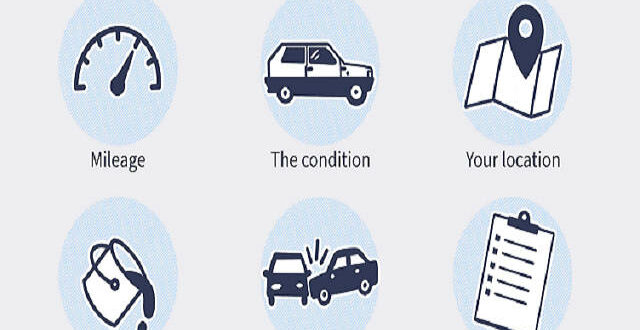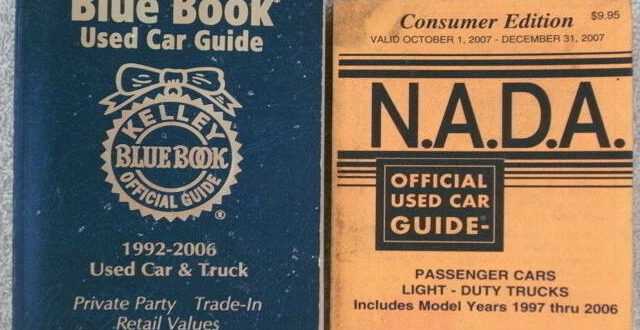Nada Used Truck Value: Your Essential Guide to Navigating the Market sale.truckstrend.com
The world of used trucks is vast, dynamic, and often complex. Whether you’re a seasoned commercial fleet manager, a small business owner looking for a reliable workhorse, or an individual seeking a powerful personal vehicle, determining a fair and accurate price for a used truck can be a significant challenge. This is where Nada Used Truck Value emerges as an indispensable tool. Far more than just a simple price list, it represents a meticulously researched and widely respected industry standard that empowers buyers, sellers, lenders, and insurers with critical valuation insights.
In this comprehensive guide, we will delve deep into what Nada Used Truck Value entails, why it holds such prominence, how to effectively utilize it, the myriad factors that influence its calculations, and practical advice to help you make informed decisions in the vibrant used truck market.
Nada Used Truck Value: Your Essential Guide to Navigating the Market
What is NADA Used Truck Value? Understanding the Foundation
At its core, NADA Used Truck Value refers to the valuation data provided by the National Automobile Dealers Association (NADA) Guides, which are now officially part of J.D. Power Valuation Services. For decades, NADA has been the gold standard for vehicle valuations, relied upon by professionals across the automotive and financial sectors.
NADA’s valuation methodology is sophisticated and data-driven. It’s not based on arbitrary figures but rather on a comprehensive analysis of:
- Actual Sales Data: Information gathered from countless wholesale auction results and retail transactions across the country.
- Dealer Surveys: Direct input from dealerships about current market conditions, demand, and regional pricing.
- Economic Factors: Consideration of broader economic trends, fuel prices, interest rates, and new vehicle sales that can impact used vehicle demand.
- Vehicle Attributes: Detailed analysis of specific truck models, their trim levels, engine types, transmissions, and optional equipment.

For trucks, NADA provides various value types, each serving a specific purpose:
- Clean Trade-in: The estimated value a dealer would offer for a well-maintained truck in good condition.
- Average Trade-in: A value for a truck with some wear and tear, typical for its age and mileage.
- Rough Trade-in: For trucks requiring significant reconditioning or repairs.
- Clean Retail: The estimated price a consumer would pay at a dealership for a truck in excellent condition after reconditioning.
- Average Retail: The price for a truck in good, average condition at retail.
- Loan Value: A figure often used by lenders to determine the maximum loan amount they are willing to provide against the truck’s value.


This multi-faceted approach ensures that NADA Used Truck Value offers a balanced and realistic assessment, reflecting true market conditions rather than subjective opinions.
Why NADA Used Truck Value Matters: Benefits for Every Stakeholder
The widespread adoption of NADA values is a testament to their utility and reliability. Different stakeholders leverage this data for distinct, yet equally critical, purposes:
-
For Buyers (Individuals & Businesses): NADA empowers buyers to approach negotiations with confidence. By knowing the fair market value, you can avoid overpaying and ensure you’re getting a good deal. It helps in budgeting and understanding the financial commitment involved. For businesses, it’s crucial for capital expenditure planning and ensuring fleet acquisitions are cost-effective.
-
For Sellers (Private & Dealers): If you’re selling a used truck, NADA provides a credible baseline for setting your asking price. It helps justify your price to potential buyers and can accelerate the sales process by instilling trust. Dealers use NADA to price their inventory competitively, manage trade-ins, and optimize profitability.
-
For Lenders & Financial Institutions: NADA values are indispensable for risk assessment. Lenders use the "Loan Value" to determine the loan-to-value (LTV) ratio, ensuring the collateral (the truck) sufficiently covers the loan amount. This protects both the lender and the borrower from excessive debt.
-
For Insurance Companies: In the event of a total loss, insurance companies rely on NADA values to calculate fair payouts. This ensures policyholders receive appropriate compensation for their damaged or stolen trucks, and helps insurers manage their claims effectively.
-
For Fleet Management & Asset Valuation: Businesses managing large fleets use NADA values for regular asset valuation, depreciation tracking, and making informed decisions about when to retire or upgrade vehicles. It provides a standardized method for accounting and financial reporting.
How to Use NADA Used Truck Value: A Step-by-Step Guide
Accessing and interpreting NADA Used Truck Value is straightforward, but requires attention to detail to ensure accuracy. Follow these steps:
-
Access the NADAguides Website: Navigate to the official NADAguides website, which redirects to J.D. Power’s valuation services. Look for the "Trucks" or "Commercial Trucks" section, depending on the type of truck you’re valuing.
-
Input Basic Vehicle Information:
- Year: The model year of the truck.
- Make: The manufacturer (e.g., Ford, Ram, Chevrolet, Freightliner, Kenworth).
- Model: The specific model (e.g., F-150, Silverado 2500HD, Ram 3500, Cascadia, T680).
- Body Style/Cab Type: (e.g., Regular Cab, Extended Cab, Crew Cab, Chassis Cab, Day Cab, Sleeper).
-
Specify Engine & Drivetrain:
- Engine Type: V6, V8, Diesel, specific engine displacement (e.g., 6.7L Power Stroke, Cummins, Detroit Diesel). This is particularly critical for trucks as engine choice heavily impacts performance and value.
- Transmission: Manual or Automatic, and the number of gears.
- Drive Type: 2WD (Two-Wheel Drive) or 4WD (Four-Wheel Drive).
-
Enter Mileage: This is perhaps the most crucial factor for used trucks. Enter the exact odometer reading. NADA’s system will automatically adjust the base value based on whether the mileage is higher or lower than the average for that year and model. For commercial trucks, hours of operation might also be considered if applicable.
-
Select Options and Features: This is where the value can significantly fluctuate. Be thorough and accurate:
- Standard Features: Confirm features included in the specific trim level.
- Optional Equipment: (e.g., tow package, bed liner, navigation system, sunroof, upgraded wheels, premium audio).
- Commercial/Specialized Equipment: For commercial trucks, this is paramount. Include items like dump beds, service bodies, lift gates, PTO (Power Take-Off), snow plow prep packages, specialized axles, auxiliary fuel tanks, or sleeper cabs. These additions can add substantial value.
-
Assess and Select Condition: This requires an honest and objective evaluation. NADA typically offers:
- Clean: Excellent mechanical and cosmetic condition, well-maintained, minimal wear.
- Average: Good mechanical condition, some normal wear and tear, minor cosmetic flaws.
- Rough: Mechanical issues, significant cosmetic damage, requires considerable reconditioning.
- Be realistic. Overstating condition will lead to an unrealistic valuation.
-
Review the Values: After inputting all details, NADA will present the different valuation types (Trade-in, Retail, Loan) adjusted for your specific truck. Understand which value is most relevant to your situation (e.g., if you’re selling to a dealer, focus on trade-in; if buying from a dealer, look at retail).
Key Factors Influencing NADA Used Truck Value
While the NADA guide provides a robust framework, several underlying factors constantly shape and shift the final valuation:
- Mileage and Hours: For trucks, particularly commercial ones, high mileage or extensive hours of operation (for equipment with PTO or stationary work) can significantly depreciate value, as it indicates greater wear and tear on critical components. Lower mileage generally commands a premium.
- Overall Condition (Mechanical & Cosmetic): A truck free of major mechanical issues, with a clean interior and exterior, well-maintained tires, and functioning features will always command a higher value. Evidence of diligent maintenance (service records) adds significant credibility.
- Maintenance History: A comprehensive record of regular maintenance, oil changes, and professional repairs demonstrates responsible ownership and contributes positively to value. It assures future buyers of the truck’s reliability.
- Features, Upgrades, and Specialized Equipment: Factory options like larger engines, advanced towing packages, navigation, and luxury interiors can boost value. For commercial trucks, specialized bodies (dump, flatbed, service), heavy-duty axles, or power take-off (PTO) systems are critical value drivers.
- Market Demand and Economic Conditions: The popularity of a specific make/model, current fuel prices, interest rates, and the overall economic climate (e.g., boom in construction leading to higher demand for work trucks) directly impact values.
- Geographic Location: Values can vary regionally due to local demand, climate (e.g., 4WD trucks might be more valued in snowy regions), and regional economic activities.
- Accident History and Title Status: A truck with a clean title and no reported accidents will always be worth more. Salvage, rebuilt, or flood-damaged titles drastically reduce value and can make a truck difficult to insure or finance.
Challenges and Considerations When Using NADA Used Truck Value
While NADA is an invaluable resource, it’s important to acknowledge its limitations and potential challenges:
- Highly Specialized Commercial Trucks: For extremely specialized or custom-built commercial trucks (e.g., concrete mixers, refuse trucks, highly modified vocational vehicles), NADA’s standardized categories might not fully capture the unique value of the specialized equipment. In such cases, a professional appraisal might be necessary.
- Rapid Market Fluctuations: The used vehicle market, especially for trucks, can react quickly to economic shifts, fuel price changes, or supply chain issues. While NADA updates frequently, there can be a lag, or very recent, sharp shifts might not be immediately reflected.
- Subjectivity of Condition: What one person considers "clean" might be "average" to another. This subjective element can lead to disagreements in valuation. Objective assessment and third-party inspections are crucial.
- It’s a Guide, Not a Guarantee: NADA provides a guide, a strong indicator of value, but it is not a fixed price. The final sale price will always be subject to negotiation between buyer and seller, local market conditions, and the specific circumstances of the sale.
- Aftermarket Modifications: NADA typically accounts for factory options. Aftermarket modifications (e.g., lift kits, custom audio, non-OEM performance upgrades) are generally not included in NADA’s calculations and may or may not add value depending on the buyer’s preference.
Practical Advice and Actionable Insights
To maximize the benefits of NADA Used Truck Value and navigate the market effectively:
- Always Cross-Reference: While NADA is paramount for trucks, consider checking other valuation sources like Kelley Blue Book (KBB) or Edmunds for comparison, especially for light-duty consumer trucks. Understand their methodologies and target audiences.
- Combine with Physical Inspection: NADA provides a numerical value, but a thorough physical inspection by a qualified mechanic is irreplaceable. This will confirm the truck’s actual condition and identify any hidden issues.
- Research Comparable Sales: Look for recently sold trucks of the same make, model, and year in your local area. This real-world data can help calibrate the NADA value to your specific market.
- Be Honest About Condition: Whether buying or selling, be realistic about the truck’s condition. For sellers, transparency builds trust. For buyers, a clear understanding prevents disappointment.
- For Sellers: Document Everything: Have all maintenance records, repair receipts, and details of any installed options readily available. This substantiates your asking price and reassures buyers.
- For Buyers: Get a Pre-Purchase Inspection (PPI): Before finalizing a purchase, invest in a PPI from an independent mechanic. This can uncover issues not apparent during a test drive or visual inspection.
- Negotiate Smart: Use the NADA value as your anchor point in negotiations. Be prepared to justify your offer (as a buyer) or your asking price (as a seller) based on the truck’s specific condition and features relative to the NADA guide.
Illustrative NADA Used Truck Value Table (Example Data)
Please Note: The values in this table are purely illustrative and hypothetical. Actual NADA values vary daily based on market conditions, specific features, and exact mileage. Always use the official NADAguides/J.D. Power website for the most accurate, real-time valuations.
| Truck Model & Type | Year | Mileage Range (Approx.) | Clean Trade-in Value | Clean Retail Value |
|---|---|---|---|---|
| Ford F-150 (V8, 4×4, Crew) | 2018 | 75,000 – 85,000 | $25,000 | $29,500 |
| Ram 2500 (Cummins Diesel, 4×4, Crew) | 2017 | 100,000 – 110,000 | $38,000 | $44,000 |
| Chevrolet Silverado 3500HD (Gas, Dually, Reg Cab, Chassis) | 2019 | 60,000 – 70,000 | $32,000 | $37,500 |
| Freightliner Cascadia (Sleeper, Diesel) | 2016 | 450,000 – 500,000 | $28,000 | $34,000 |
| Ford Transit 250 (High Roof, Cargo Van) | 2020 | 50,000 – 60,000 | $26,000 | $31,000 |
Frequently Asked Questions (FAQ) about NADA Used Truck Value
Q1: Is NADA the only reliable source for truck values?
A1: While NADA (J.D. Power Valuation Services) is widely considered the industry standard, especially for commercial and dealer-centric valuations, other sources like Kelley Blue Book (KBB) and Edmunds also provide useful consumer-oriented values. It’s often beneficial to consult multiple sources.
Q2: How often are NADA values updated?
A2: NADA values are updated regularly, typically on a monthly basis, to reflect the latest market trends, sales data, and economic conditions. This ensures the valuations remain as current and accurate as possible.
Q3: Does NADA account for aftermarket modifications?
A3: Generally, NADA values primarily account for factory-installed options and trim levels. Aftermarket modifications (e.g., custom lift kits, performance chips, elaborate sound systems) are typically not factored into NADA’s base calculations and may or may not add value depending on buyer preference and market demand.
Q4: Can I trust NADA for commercial truck values?
A4: Yes, NADA is highly trusted for commercial truck values, ranging from light-duty work trucks to heavy-duty vocational vehicles and semi-trucks. They have specific guides and data points tailored to the unique aspects of the commercial vehicle market, including specialized equipment.
Q5: What’s the difference between "trade-in" and "retail" value?
A5: "Trade-in" value is what a dealership might offer you for your truck if you’re trading it in towards another vehicle. It’s lower than retail because the dealer needs to recondition the truck and make a profit. "Retail" value is the estimated price you would pay if you bought the truck from a dealership, reflecting the cost of reconditioning, overhead, and profit margin.
Q6: Why is mileage so important for trucks compared to cars?
A6: Mileage is crucial for trucks because they are often used for heavier work, towing, hauling, or commercial purposes, leading to more wear and tear on the engine, transmission, and chassis compared to a typical passenger car. High mileage on a truck can indicate a greater likelihood of needing significant maintenance or repairs sooner. For commercial trucks, "hours" can be just as important, indicating engine run-time even when not driven long distances.
Conclusion
In the dynamic and often opaque world of used truck sales, Nada Used Truck Value stands as a beacon of clarity and reliability. By providing meticulously researched, data-driven valuations, it levels the playing field for all participants, fostering transparency and fairness. Whether you’re making a significant purchase, planning to sell, or managing a fleet, understanding and effectively utilizing NADA’s comprehensive guides is not just an advantage—it’s a necessity. It empowers you to make informed decisions, negotiate with confidence, and ultimately, secure the best possible value for your used truck.




